tldr (too-long, didn’t read summary): Danny Rampling made love to our ears until the walls of Freddie’s were sweating tears of relief and release. Primal, magical, feral, life affirming. I danced until 4am, then lay in bed awake until noon because the heartstrings plucked by the night wouldn’t stop vibrating. I finally understand (some of) Ibiza’s magic and why the island has a mythical reputation.
The year 2024 started with the legal finalization of my divorce. In October, I celebrated my birthday week in Ibiza, where I danced all night (on multiple nights) with my girlfriend, candy-flipped, mushroom-tripped, and even allowed myself to cut loose and drink caffeinated cappuccino and alcoholic champagne — two beverages I normally abstain from. In short, I cut myself loose from a 23-year marriage, then cut loose in a six-day party spree. Could I be any more of a walking, dancing middle-aged cliché of a mid-life crisis? We shall see. (The year 2025 is looking over 2024’s shoulder whispering into its ear, “hold my beer.”)

Pikes Ibiza was created when Tony Pike (pictured above with George Michael on the set of Wham’s Club Tropicana video), an international playboy, self-admitted insurance fraudster, small-time drug dealer, and self-described well-hung lover of men and women (notable lovers included Grace Jones and George Michael) purchased a 15th century finca (rural estate) and converted it into a boutique hotel. Due Tony Pike’s influence and hard work, Pikes became infamous for hedonistic parties — Freddie Mercury celebrated his 41st birthday there in 1987 (at a cost of £52,000 — about $137K in today’s dollars). The ample budget allowed for “lots of booze and coke.”

Pikes today, 40+ years on, has settled down a bit, but the legendary energy of Ibiza still flows freely from the beating heart of the place, a tiny, dungeon-like dancefloor with walls of stone, low, wood-beamed ceilings, and a soundsystem loud enough and clear enough to cast a spell over dancers. This room, the magical wellspring from which Pike’s party vibes gush, is named Freddie’s room because it was Freddie Mercury’s preferred suite when he stayed at Pikes. It was converted to a party space after his death in 1991.
Like Studio 54, Paradise Garage, David Mancuso’s Loft, and The Warehouse, Freddie’s has become a legendary dancefloor, revered for the quality of DJ talent it attracts and for the raucous fun people have had there over the decades. All of the nights at Freddie’s have different themes, changing over the course of a season that runs from April through October. The reason I’d flown to Ibiza was to celebrate my birthday at its famous Manumission Monday night, where the DJ wouldn’t be pre-announced, where phones would be stickered and forbidden from use on the dancefloor, and where, as Pikes themselves put it, “like-minded partygoers and island residents alike come together to embrace the freedom of being in a Balearic paradise while dancing to the sounds of the world’s finest DJs.”

It would be our third night of clubbing in Ibiza, and I expected it to be the best night. After the horror of Hi Ibiza two nights before, we needed to dance ourselves clean. Despite hyping myself up about the place, Pikes surpassed my lofty expectations, and here are a few impressions from the night that attempt to capture what it was like to attend a dance party there.
Because great parties cause time to warp, slow, stop, and stutter, this is a collection of vignettes or moments when I realized that this party was doing the soul-cleansing job I had hired it to do. The night went by in a blur. The night went by in a halting rhythm of fevered forever nows. Some of what happened can’t be published until the posthumous memoir because it’s just too spicy.
Dinner at Pike’s Restaurant — the Freddie’s backdoor. We started the night with 8pm dinner at the Pikes restaurant. Restaurant reservations include entry into Freddie’s, so having reservations locked down allowed me to book flights and hotels with confidence a couple months in advance, whereas Freddie’s RSVPs open up only two weeks before each event. The staff were friendly and dressed for the party in Hawaiian-style shirts with graphic prints of disco balls, monstera plants, and guitars. The food was solid, and the sparkling firework in my birthday cake felt like the official kick-off moment for the party. Freddie’s is free to enter, but dinner comes with an €85/head minimum which I figured was worth it to avoid the risk of flying all the way to Ibiza only to fail to get in to Freddie’s on my birthday night.
The Freddie’s dance floor and soundsystem. Freddie’s is tiny — I’ve seen walk-in closets in California McMansions that can fit more dancers. It’s got room for maybe 200 people, with the total capacity for Pikes on a busy evening hovering around 800 people. There are other party and hang-out spaces secreted throughout the beautiful grounds. Inside Freddie’s room, A small portrait of Saint Freddie is pinned high on a wall near the elevated DJ booth tucked into the back corner.
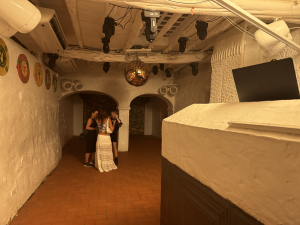
Pictured above’s the photo I snuck of Freddie’s before it was officially open. At first glance, I thought it would be an acoustic nightmare of sound reflections what with stone walls, tiled floor, and low ceiling. I worried that reflections off the hard surfaces might make the music sound awful, but once the room was packed with people, the sound system’s impressive volume didn’t muddy its clarity.
After all, human bodies are great acoustic treatment for a room — John Klett, the designer of the Despacio soundsystem, said in one interview, “I refer to people as walking water bags – with maximum respect and love,” he laughs. “Because the dancers are part of the experience, part of our acoustical treatment, they make the system sound better.”

The walls of Freddie’s. Perhaps more than any feature of Freddie’s, I know its walls the best. Made of plastered and painted stone, their honest bumpiness felt like safety when the room reached the heights of Bacchanalian chaos. Pikes only allows attendees age 27+, so generally speaking, attendees have some experience and know how to hold their substances. Even so, I saw plenty of folks holding onto, leaning against, and generally using the walls for support and grounding because the room was so disorienting and confusing at times. There were times when the room was pitch black or barely lit or so pumped full of stage smoke that I couldn’t see even my dance partner in front of me. I could only surrender to the overwhelm and wash of beats and put my palms against the bumpy walls to steady my bouncing, gyrating and writhing. Twice we tried to dance in the middle of the room, and on both occasions we felt like rowboats in a winter squall — bumped and tossed from every direction.
Every once in a while, someone would slide along the wall and bump into me. These wall sliders were trying navigate out of the room for a drink or rest, and in the chaos the wall was the only way to see their way out. I dared not let go of the wall for fear of being pushed back out to sea and swept up in a current, unmoored and lost. Sorry to all the wall sliders I made go around us — I was at times in jeopardy of losing my own sanity and could not let go of the wall.
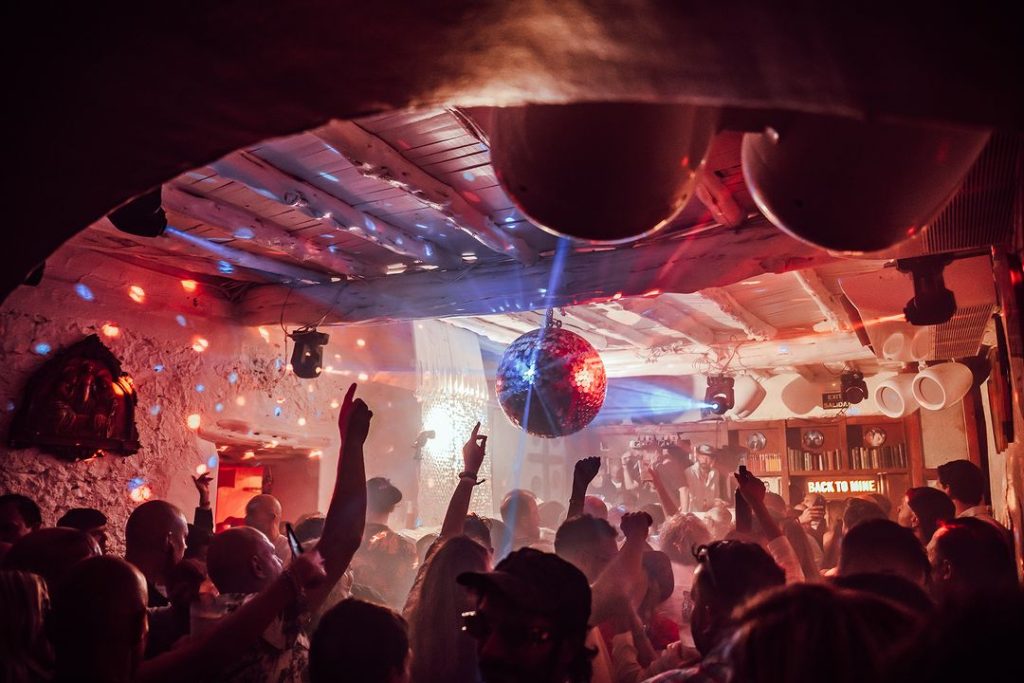
As the night wore on, I noticed the walls had begun to drip with condensation of so many sweating bodies. The place had been packed from opening, and the DJ had us working up a sweat.
Communion. I don’t know what came over me, but feeling connected to the room, I gathered some of that wall condensation on my index finger and touched my forehead, my chest, my left shoulder, and finally my right shoulder, repeating a familiar old motion I probably hadn’t done in 40 years, re-baptizing myself with the sacred sweat of the gathered bodies. As the water on my forehead cooled, I had another idea.
I gathered more condensation from the wall onto my finger and licked it off. My motivation was sacred, not sacrilegious. I felt the need to join my water with water that had been part of all those other bodies — after all, we move as one body when we move to the one beat of one song in one room. As a kid, I’d been fascinated when a teacher told my class that molecules of water that had once been in Julius Caesar had likely had time to make their way into every living human. No idea if that was scientifically sound, but that old story made consuming some of the condensed sweat feel like the right thing to do. I wanted to both give my sweat to the air and take some back from the hundreds gathered in Freddie’s on a Monday night.
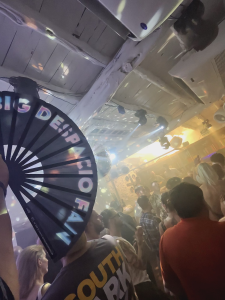
The ceiling of Freddie’s. With its bumpy walls and low ceiling, pulsing with the heartbeat of song and the press of human flesh, Freddie’s felt like a womb. I regularly whacked the speakers and disco ball when I raised my hand to fan myself with the hand fan I’d brought along for comfort. With its rustic wood beams made of painted tree trunks, the ceiling breaks up sound that might otherwise reverberate unpleasantly. In moments when there was enough light to see the ceiling, the organic construction and honest materials show up without the artifice of high-tech sound paneling found in Ibiza’s superclubs — yet another reminder of the humility and humanity of the experience.
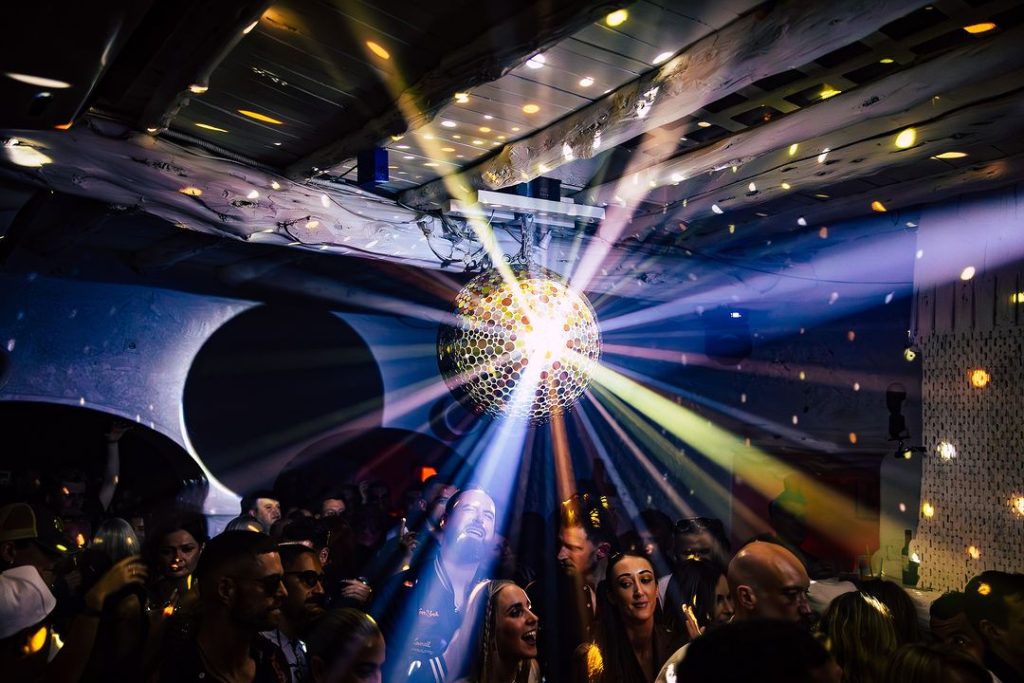
The lights and the mirror ball. The disco ball at the center of the room features circular mirror tiles and it feels rigidly fixed to the ceiling. It doesn’t dangle and spin like many disco balls. As opposed to some experiences, where the mirror ball is a rare treat, lit only for emotional high points, this ball was lit for 10+ minutes at a time at times, speckling the walls, ceiling, and faces with particolored circles of light. The ball is fixed, the people below it provide the movement. Freddie’s lighting (controlled by technician and lighting director Lorenzo, pictured with me, below) goes through a range of effects, at times feeling like a romantic dinner lit by gentle caresses of candle light, to at times feeling like a dubstep or hard techno rave strobing between foggy whiteouts and inky, moonless night.
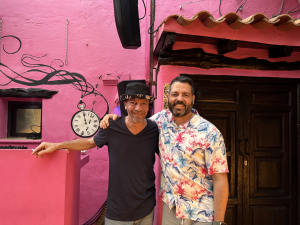
My first impressions of the lighting rig were that it was underpowered for the room. Seeing the subtle sequences of the first several songs, I misjudged the lighting to be quaint and perhaps out of date. But I was wrong, because Lorenzo was keeping his cards close to his vest. Later in the night, after the DJ had jellied our brains, Lorenzo played lighting sequences timed to musical phrasing and emotional energy. At times the lighting was giving dystopian hellscape. At times it gave urgent finale to an orgy. At times it gave rennaissance watercolor, full of blooms and color washes. Lorenzo, who is always present, is a lighting master.
Heartbreak and healing. One of the songs the DJ played in the first hour was “Movin’ on Up” by M People, a positive break-up anthem that, to be honest, I’d never paid much attention to before. I’d enjoyed the song, heard it probably a dozen times, but I’m the type of person who doesn’t really hear lyrics — the human voice is just there like an instrument. But this time was different — I saw my girlfriend, also recently divorced, move to the song in a way that made me sit up and pay attention when I saw her singing along to the lyrics, the chorus of which goes:
… ‘Cause I’m movin’ on up, you’re movin’ on out
Movin’ on up, nothin’ can stop me
Movin’ on up, you’re movin’ on out
Time to break free, nothin’ can stop me
These lyrics don’t apply to my situation, but they clearly resonated with her, and I heard this song for the first time through the ears of someone who had broken free from the tyranny of a bad situation and found herself dancing in Freddie’s room at Pikes Ibiza. As watched my girlfriend dance, I heard the 30-year-old song essentially for the first time, finally understanding it as more than just a pop-dance tune. I was about 20 when I first heard the song and hadn’t had to deal with heartbreak, break-up, or any of that yet. How could I have possibly understood it as anything other than pop?
Just before 3am, we took a break for water, stumbling out into the patio to sit down near the back door of Pikes, the same patio where we’d eaten dinner seven hours prior. The dry night air pulled the moisture out of my sweat-soaked shirt, and felt gloriously cooling. The patio was a babel of people happily chatting in so many languages, laughing, and smoking. The high-frequency tinkle of ice cubes in drinks complemented the filtered-down rhythmic thumping we could hear from Freddie’s.

“This is a fun corner,” said a posh English voice.
I looked up, and a man with strikingly metrosexual caterpillar eyebrows smiled down at us. He introduced us to his friends, and soon we were chatting about birthdays in Ibiza — he’d celebrated his milestone birthday on the island earlier that year — and, unprompted, he gave a review of his experience at Hi Ibiza that largely mirrored our own, “it’s too fucking crowded. You can’t leave for a drink of water or the restroom because you won’t get back in.”
One topic led to another, then The Englishman told us a wry story of a somewhat tragic breakup, but he told it well and we laughed. Then we decided as a newly enlarged group of instant friends that the best response to a helluva breakup story was to go back inside to dance. We got back in, no problem.
Frankie Knuckles’ Your Love was the next song the DJ played, mixing into it from Hideaway (Classic Mix) by David Morales, a cover of a 1994 deep house track, followed by the synthy modern house track Dale Dale by DJ Tennis & Luke Alessi, a three-track run that catapulted us from early house to electronic/trancey house, laying the groundwork for a spectacular final hour. The dancefloor was once again packed, as folks from the patio poured back inside for the finale and as the DJ transitioned from house to trance with a song that messed with my head and made me question who was in the DJ booth. More about that song in a moment.
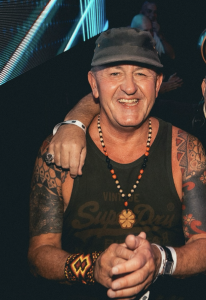
Who? Danny Rampling. Two months before we flew to Ibiza, I’d booked our night at Pikes without knowing (and without having a way of knowing) who the secret DJ would be, only knowing that Monday nights at Pikes had a reputation for being the best night of many great nights.
So we arrived at Pikes, ate dinner, and started dancing still without knowing who the DJ was. We never even looked into the DJ booth, as the true test of a dance floor isn’t whether the DJ is dancing cutely for the socials or whatever, but what effect they have on the dancefloor. The modern desire to watch the DJ (vs. just dance and feel what the DJ is putting out) makes as much sense as watching a chef cook without eating the food coming out of their kitchen.
And so we danced to whatever the DJ played for four and a half hours without knowing who the DJ was, and without it really mattering. What mattered was his track selection, the vibes, and the energizing impact of his selection and mixing on the dancefloor.
So I mentioned that the trance song the DJ played that made me really sit up and take notice — that song was Follow Me (Hidden Identity Extended Remix) by Jam & Spoon, a trance/techno number with a minute-and-half break in the center when all the percussion drops out and layered synth chords rose and fell, like an air raid siren. I could not see the rest of the dance floor, but the only answer to this was to embrace in a hug, and just sway as the warm, liquid ambrosia of synth bathed the creases and folds of my brain. (Click here to listen to this fantastic moment on YouTube — imagine what this might feel like on a soundsystem my phone tells me was set to about ~108dB.) It felt like the DJ was using sound-based telekinesis to perform laparoscopic surgery through the ear holes in my skull in order to CRISPR my DNA into some evolved form of post-human super-being. I’m sure the science totally checks out on that tortured metaphor, but to put it more simply, it was a proper mindfuck that made me need to know who the DJ was. A minute-and-a-half with no beat would empty a lot of dancefloors, but we were locked in to it.
Tunes by Afrojack (Rock the House) , Slam (Lifetimes), Hardfloor (Acperience 1), Frankie Goes to Hollywood (Relax – Jam & Spoon mix), A Split-Second (Flesh), and In and Out (Eric Prydz) followed. After the final tune, the crowd fell into chants of “otra” (as in one more song) but curfew was strict, and we were soon flowing out of the room.
On my way out, I stopped by the DJ booth to thank the DJ, a gentleman who looked to be in his 50s.
“What’s your name?” I asked, and stuck out my hand.
He took it, “I’m Danny Rampling,” he said. British. Strong grip, tattooed arm, a five-inch beaded bracelet, if memory serves.
“Danny Rampling?” I repeated to make sure I’d heard him. I had no idea who it was. (Note: I’m pretty ignorant!) My girlfriend — who grew up in the UK — elbowed me and whispered, “Legend!”
“Where are you from? America?” he asked.
“California,” I said.
Someone nearby watching our exchange asked, “LA?”
“Yeah,” I said.
“God help you,” he said, then he cackled . “LA’s gone bonkers! Nice to meet you, brother.”
Back in the car, I searched Danny Rampling’s name, because I’d never heard of him. I learned that he’s been widely credited as one of founders of UK’s rave and club scene (in the early 1980s), and that he’s been a host of various BBC radio programs, et cetera. The guy really is a legend, and I learned (when I returned to Pikes two days later to revisit the scene), that he’s returned to DJing after retiring for a while and needing to take a break from loud rooms for hearing-related reasons.
I find it stunning that Danny Rampling is the sort of world-class talent that Pikes can book for a secret gig on a Monday night. What’s more stunning was the contrast between a dancefloor where probably half the attendees were, like myself, ignorant of who was on the decks. We’d come to dance, not stand still with our phones out filming the celebrity DJ for the purpose of building or feeding our social media followings. Freddie’s was a pure dancefloor: just DJing, just dancing, and just plain fun.
If there were a Michelin guide to dancefloors of the world (there really should be), Freddie’s was three star (the highest rating). The only other three-star dancefloor I’ve experienced is of course Despacio.
Pikes Policies. A big part of what makes Pikes work so well was the fact that Pikes stickered the camera lenses on phones as their way in, telling attendees that phone photography and filming wouldn’t be welcome. The no-phones policy has long been part of Monday nights at Pikes, and earlier in the summer, the hotel extended the no-phones policy to all seven nights, writing in their post announcing the change, “Keeping your phone in your pocket and your mind on the music – and knowing that everyone around you is doing the same – opens up a whole world of freedom, not only on the dancefloor but all around Pikes.” Right on.
What’s more, Pikes requires that Freddie’s attendees be age 27+, and a few other important rules:
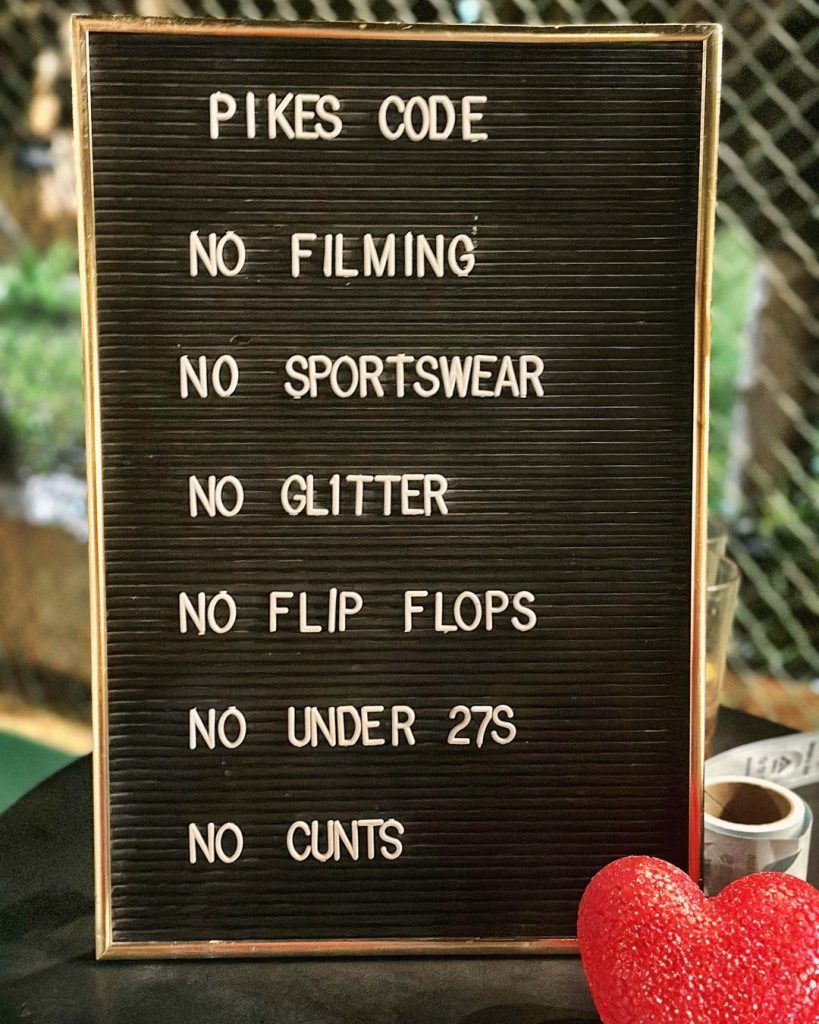
Pikes is a masterclass on how to host a great dance party. They’ve got the basics just right: great music played loud on a well-tuned soundsystem inside a dimly-lit room with wonderful attention to facilities and safety. No intrusive security pat-downs at the gates, no extortionate pricing, and no cunts. Couldn’t have asked for a more perfect birthday party.
Fatboy Slim has said, “Pikes for me is the spirit of Ibiza.” True for me as well, now that I’ve experienced Ibiza’s so-called best and compared it to Pikes’ superior offering.